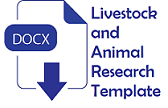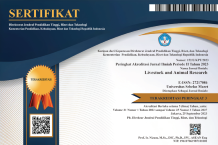Blood metabolites profile and Growth Hormone mRNA expression of Peranakan Ongole cattle fed with finishing ration containing Vinasse-molasses
Abstract
Objective: This study aimed to investigate effects of Molasses replacement with Vinasse-molasses in ration on the blood metabolite profiles and mRNA expression of Growth Hormone 1 (GH1) of finishing Peranakan Ongole (PO) Cattle.
Methods: Ten male PO cattle in averaged 209 ± 21 kg of body weight were equally allocated to receive either molasses or Vinasse-molasses dietary treatments. The concentrate diet was contained of either 15% of molasses (control) or Vinasse-molasses. This study observed the nutrient intake, percentage of weight gain, blood metabolite profiles and GH1 mRNA expression of PO cattle.
Results: The result showed that replacing molasses with vinasse-molasses reduced (P<0.05) dry matter intake (DMI) and intakes of crude protein (CP), ether extract (EE), crude fiber (CF), and total digestible nutrient (TDN). Nevertheless, Vinasse-molasses inclusion did not change (P>0.05) percentage of weight gain. Vinasse-molasses increased (P<0.05) the blood urea nitrogen level, while it did not affect (P>0.05) the GH1 mRNA levels.
Conclusions: It can be concluded that replacing molasses with vinasse-molasses does not change blood metabolite profile, GH1 mRNA expression and performance of PO cattle. Vinasse-molasses could be applied as energy sources ingredient to replace molasses in finishing cattle feed.
Keywords
Full Text:
PDFReferences
- Mordenti, A. L., E. Giaretta, L. Campidonico, P. Parazza, and A. Formigoni. 2021. A review regarding the use of molasses in animal nutrition. Animals. 11(1):1–17. Doi: 10.3390/ani11010115
- Parsaee, M., M. Kiani Deh Kiani, and K. Karimi. 2019. A review of biogas production from sugarcane vinasse. Biomass Bioenergy. 122:117–125. Doi: 10.1016/j.biombioe.2019.01.034
- Gerimipour, A. R., M. Azin, and M. R. Sanjabi. 2019. The effect of vinasse on the growth performance and feed digestibility of holstein male calves. Acta Sci. 41(1):1–7. Doi: 10.4025/actascianimsci.v41i1.45666
- Jiang, H. and X. Ge. 2014. Meat science and muscle biology symposium-mechanism of growth hormone stimulation of skeletal muscle growth in cattle. J. Anim. Sci. 92(1):21–29. Doi: 10.2527/jas.2013-7095
- Heo, Y-T., J-J. Park, and H. Song. 2015. The effect of glucose and glucose transporter on regulation of lactation in dairy cow. Reprod. Dev. Biol. 39(4):97–104. Doi: 10.12749/RDB.2015.39.4.97
- Nishad, R., D. Mukhi, R. K. Menon, and A. K. Pasupulati. 2018. Growth hormone and metabolic homeostasis. EMJ Diabetes. 6(1):78–87. Doi: 10.33590/emjdiabet/10313977
- Maneerat, W., S. Prasanpanich, S. Tumwasorn, V. Laudadio, and V. Tufarelli. 2015. Evaluating agro-industrial by-products as dietary roughage source on growth performance of fattening steers. Saudi J. Biol. Sci. 22(5):580–584. Doi: 10.1016/j.sjbs.2015.01.015
- Zali, A., M. Eftekhari, F. Fatehi, and M. Ganjkhanlou. 2017. Effect of vinasse (condensed molasses solubles) on performance and meat chemical composition of holstein male calves. Ital. J. Anim. Sci. 16(3):515–520. Doi: 10.1080/1828051X.2017.1298407
- López-Campos, Ó., R. Bodas, N. Prieto, P. Frutos, S. Andrés, and F. J. Giráldez. 2011. Vinasse added to the concentrate for fattening lambs: intake, animal performance, and carcass and meat characteristics. J. Anim. Sci. 89(4):1153–1162. Doi: 10.2527/jas.2010-2977
- NRC. 2016. Nutrient Requirements of Dairy Cattle. 8th ed. Natl. Acad. Press. Washington DC.
- Livak, K. J. and T. D. Schmittgen. 2001. Analysis of relative gene expression data using real-time quantitative PCR and the 2-ΔΔCT method. Methods. 25:402–408. Doi: 10.1006/meth.2001.1262
- da Silva, H. M., A. B. Donadia, L. F. Moreno, A. S. de Oliveira, E. H. K. B. Moraes, and K. A. K. Moraes. 2021. Prediction of dry matter intake by feedlot beed cattle under tropical conditions. Animal Production Science. 61(8):800-806. Doi: 10.1071/An18767
- Oba, M., J. L. Mewis, and Z. Zhining. 2015. Effects of ruminal doses of sucrose, lactose, and corn starch on ruminal fermentation and expression of genes in ruminal epithelial cells. J. Dairy Sci. 98(1):586–594. Doi: 10.3168/jds.2014-8697
- Moharrery, A., M. Larsen, and M. R. Weisbjerg. 2014. Starch digestion in the rumen, small intestine, and hind gut of dairy cows - a meta-analysis. Anim. Feed Sci. Technol. 192:1–14. Doi: 10.1016/j.anifeedsci.2014.03.001
- Ginting, S. P., A. Tarigan, K. Simanihuruk, Antonius, and Solehuddin. 2020. Effects of two different energy sources in total mixed diets on the performances and blood metabolites of lactating boerka goats. JITV. 25(1):32–39. Doi: 10.14334/jitv.v25i1.2196
- Moeini, M. M., S. Veyskarami, and F. Hozhabri. 2014. Effect of molasses distillers condensed soluble on nutrients digestibility, performance and some blood biological parameters in lambs. Ann. Res. Rev. Biol. 4(2):443-450. Doi: 10.9734/ARRB/2014/5482
- Shi, F. H., L. Fang, Q. X. Meng, H. Wu, J. P. Du, X. X. Xie, L. P. Ren, Z. M. Zhou, and B. Zhou. 2014. Effects of partial or total replacement of maize with alternative feed source on digestibility, growth performance, blood metabolites and economics in limousin crossbred cattle. Asian-Australas. J. Anim. Sci. 27(10):1443–1451. Doi: 10.5713/ajas.2014.14057
- Puppel, K. and B. Kuczyńska. 2016. Metabolic profiles of cow’s blood; a review. J. Sci. Food. Agric. 96(13):4321–4328. Doi: 10.1002/jsfa.7779
- Patra A. K. and J. R. Aschenbach. 2018. Ureases in the gastrointestinal tracts of ruminant and monogastric animals and their implication in urea-N/ammonia metabolism: A review. J. Adv. Res. 13:39–50. Doi: 10.1016/j.jare.2018.02.005
- Eisemann, J. H., and L. O. Tedeschi. 2016. Predicting the amount of urea nitrogen recycled and used for anabolism in growing cattle. J. Agric. Sci. 154(6):1118–1129. Doi: 10.1017/S0021859616000228
- Getahun, D., T. Alemneh, D. Akeberegn, M. Getabalew, and D. Zewdie. 2019. Urea metabolism and recycling in ruminants. Biomed. J. Sci. Tech. Res. 20(1). Doi: 10.26717/bjstr.2019.20.003401
- Dibbisa, D. and A. Duguma. 2021. The role and impacts of growth hormones in maximizing animal production- A review. Turkish JAF Sci. Tech. 9(6):975–981. Doi: 10.24925/turjaf.v9i6.975-981.3852
- Sartin, J. L., K. A. Cummins, R. J. Kemppainen, D. N. Marple, C. H. Rahe, and J. C. Williams. 1985. Glucagon, insulin, and growth hormone responses to glucose infusion in lactating dairy cows. Am. J. Physiol. Endocrinol. Metabolism. 248(1):E108–E114. Doi: 10.1152/ajpendo.1985.248.1.E108
- Qaid, M. M. and M. M. Abdelrahman. 2016. Role of insulin and other related hormones in energy metabolism - A review. Cogent Food Agric. 2:1267691. Doi: 10.1080/23311932.2016.1267691
- Firmenich, C. S., N. Schnepel, K. Hansen, M. Schmicke, and A. S. Muscher-Banse. 2020. Modulation of growth hormone receptor-insulin-like growth factor 1 axis by dietary protein in young ruminants. Br. J. Nutr. 123(6):652–663. Doi: 10.1017/S0007114519003040
- Yang, J., X. Hou, A. Gao, and H. Wang. 2014. Effect of dietary energy and protein restriction followed by realimentation on pituitary mRNA expression of growth hormone and related genes in lambs. Small Rumin. Res. 119(1–3):39–44. Doi: 10.1016/j.smallrumres.2014.02.016
- Miceikienė, I., N. Pečiulaitienė, N. Makštutienė, L. Baltrėnaitė, K. Morkūnienė, K. Liucvaikienė, and R. Mišeikienė. 2013. Cattle growth hormone and leptin genes influence on fattening traits. Cuban J. Agric. Sci. 47(3):261-265.
- Wardeh, M. F. 1981. Models for estimating energy and protein utilization for feeds: Dissertations. Utah State University. Logan.
Refbacks
- There are currently no refbacks.










